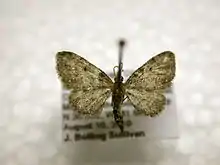Eupithecia russeliata
Eupithecia russeliata is a moth in the family Geometridae first described by Louis W. Swett in 1908. It is widespread in North America, including Alberta, California, Kentucky, Maine, Maryland, Minnesota, New Brunswick, Newfoundland and Labrador, North Carolina and Nova Scotia.
| Eupithecia russeliata | |
|---|---|
 | |
| Scientific classification | |
| Kingdom: | Animalia |
| Phylum: | Arthropoda |
| Class: | Insecta |
| Order: | Lepidoptera |
| Family: | Geometridae |
| Genus: | Eupithecia |
| Species: | E. russeliata |
| Binomial name | |
| Eupithecia russeliata | |
| Synonyms | |
| |
The wingspan is about 18 mm. Adults have been recorded on wing from May to October.
The larvae feed on Picea species and possibly other conifers.[3]
References
- Yu, Dicky Sick Ki. "Eupithecia russeliata Swett 1908". Home of Ichneumonoidea. Taxapad. Archived from the original on March 24, 2016.
- "910369.00 – 7526 – Eupithecia russeliata – Swett, 1908". North American Moth Photographers Group. Mississippi State University. Retrieved May 1, 2019.
- McDunnough, James H. (1949). "Revision of the North American species of the genus Eupithecia (Lepidoptera, Geometridae)" (PDF). Bulletin of the American Museum of Natural History. 93: 533–728.
| Wikimedia Commons has media related to Eupithecia russeliata. |
| Wikispecies has information related to Eupithecia russeliata. |
This article is issued from Wikipedia. The text is licensed under Creative Commons - Attribution - Sharealike. Additional terms may apply for the media files.
